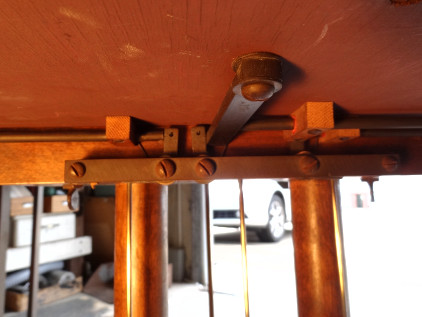Technical Library
MOVING XVIII: Reattaching the pedal lyre
Entire Contents Copyright © 2011 CBHTechnical LibraryMOVING XVIII: Reattaching the pedal lyre Entire Contents Copyright © 2011 CBH |
 |
| Trapwork of a William de Blaise Model A harpsichord (8´, buff & 4´ pedals) |
Reattaching the pedal lyre…
The modern revival type of harpsichord can
exhibit action problems following a move. This is usually because in reassembly the pedal lyre has not been correctly aligned with the trapwork on the base of the instrument, so the register limits appear out of regulation.
As they figure out how to transmit the vertical pedal motion to the sideways movement required by the registers, different makers show various approaches to lyre design. All modern harpsichords, though, should have their register travel precisely determined by the capstans provided for that purpose at the register ends, not by the pedals which should be regulated merely to provide sufficient leverage for ON and release for OFF. There are two basic systems:
1. Instruments where the top of the pedal rods push vertically onto flat paddles. These exhibit few problems, unless perhaps any cloth padding has been dislodged or compressed. The rods often have a long threaded extension for adjustment, usually with some form of locknut arrangement to prevent them turning of their own accord and adversely affecting regulation. If insufficiently tight, it is quite likely that the extensions have turned around during the move. If so, when the pedal lyre is attached, a rod can be found to be too short to fully engage the register, or (more likely because the adjuster has unscrewed) the register can’t release fully OFF.
2. Instruments where the vertical motion of the pedal rods has been transmitted to horizontal motion of the fingers, all within the top of the lyre itself. Some juggling may be required when attaching the lyre to instruments of this type, like the pictured William de Blaise. The fingers must be juggled into alignment so they bear directly on the ends of the horizontal rods attached to the harpsichord front bottom and the lyre then held up in place while the thumbscrews are tightened.
In either variety, care must be taken not to misplace the diagonal brace which fits between the back of the pedal box and a point on the instrument bottom further away from the player. This piece of often loose plain brass rod saves strain on the lyre fastening and is essential to support the pedal box from its tendency to move backwards when the player depresses a pedal.
| Technical Library overview | |
| Harpsichords Australia Home Page |